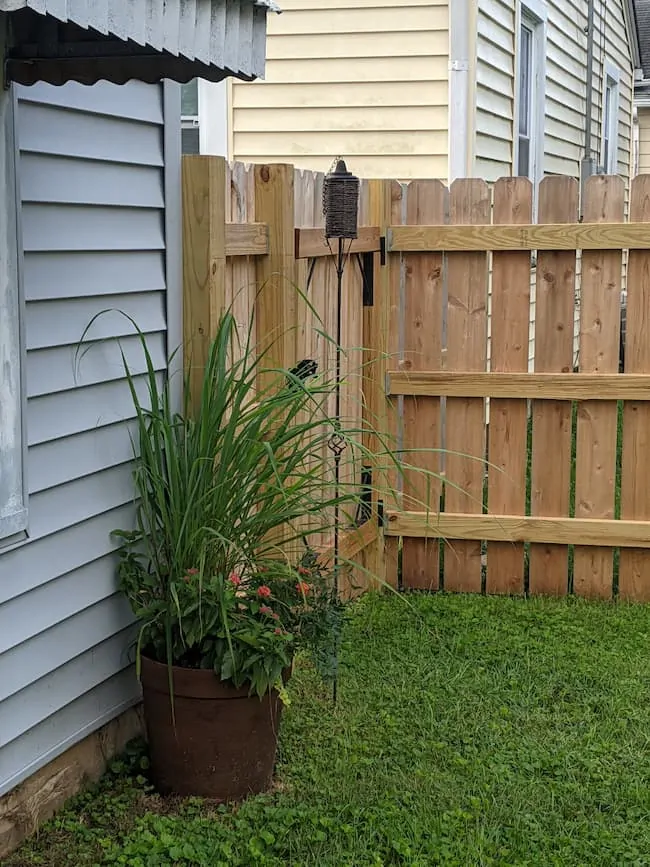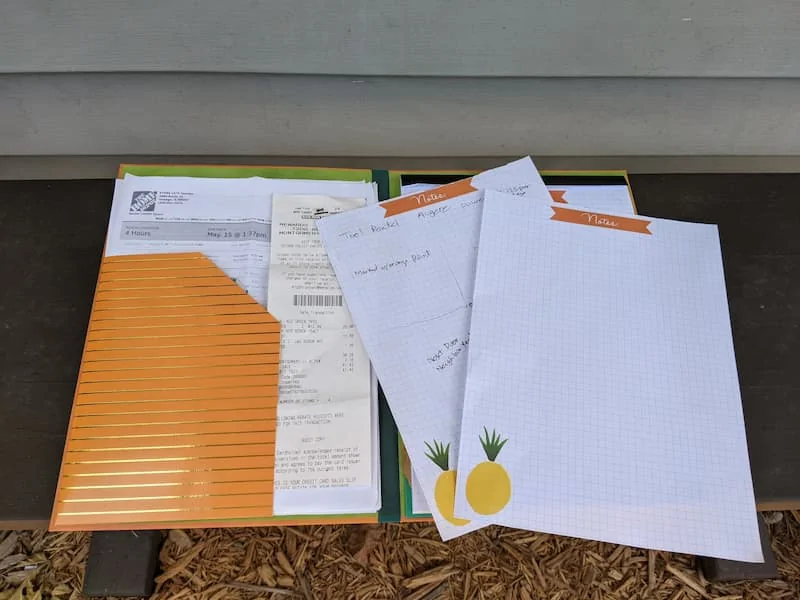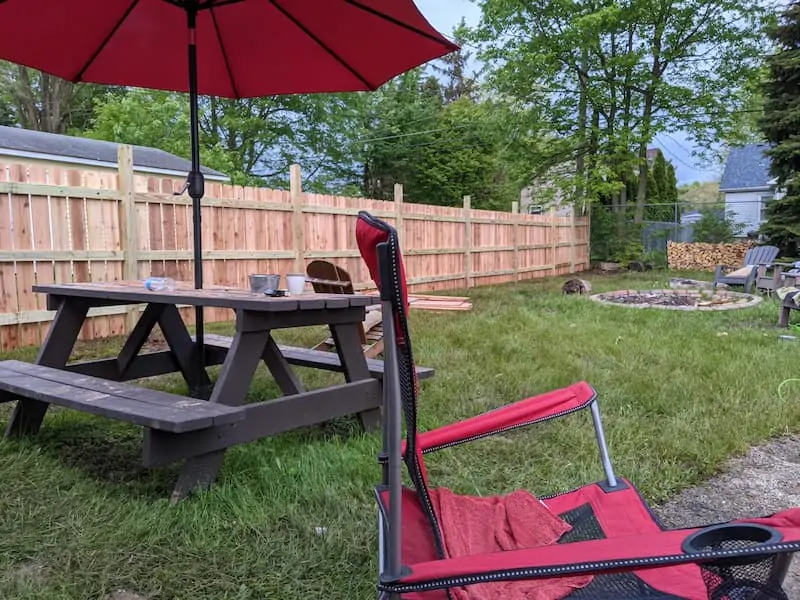Learn how to prepare and manage a big home project successfully from start to finish with these six easy organizational ideas.
Ken and I splurged on installing a wood fence in our backyard this summer. It wasn’t really in the plan. But my neighbor was anxious to put a fence up (for his dog). And I didn’t want to wait and run the risk that he might put up a chainlink fence. Not that there’s anything wrong with chainlink fences. We have one across the back of our yard. I’ve just had this vision of how much more stunning a wood fence would look. So, I spoke with my neighbor about splitting the cost for a wood fence and he was all for it. Whoop!
Additionally, he was more than willing to let me plan and execute the project. He would have hired a contractor. I on the other hand knew we’d save more money doing it ourselves. So, he told me to have at it
Unfortunately, Ken was working six-day shifts at the time. Fortunately, however, my nephew and a family friend volunteered to do the fence installation. With pay, of course. And that was okay because they still wouldn’t charge me as much as an installation company would. As a bonus, my sister showed up to help for free, as well. Thank you, M!
Now, I had never managed such a large home project before. One that included ordering materials, having the material delivered, renting heavy equipment, etc… So, I knew I was going to have to prepare and plan with due diligence. If I really wanted it all to run smoothly. Or at least without too many snags.
How to Effectively Prepare and Execute a Big Home Project

I will use our wood fence installation as a “project example”. Read on for the following six tips on how to manage a large home project effectively and with success. Meaning how to bring the project to completion, rather than almost done, partially done, or never fully completed.

Create a Centralized Paperwork Center
For starters, find a way to keep all of your paperwork (ie: plans, lists, receipts) in one centralized place. This way you won’t be running upstairs. Or into the garage. Or searching through your jean pockets to find important measurements. or any other pertinent information related to the home project.
During the planning stage of our fence installation, I grabbed a pocket binder with a clipboard feature to keep drawings, lists, and receipts in one place. And at the ready before, during, and after. And I’m glad I did this because once the job was completed, we had unused materials. So, I only had to refer to the pocket of my binder to find the pertinent receipts to bring the items back to the store for a refund. $$$

Additionally, our most referenced notes and plan drawings were readily available on the clipboard feature while we were in the midst of working.
Alternatively, you can easily pull together a standard folder with pockets, a notepad, and a clipboard. Or some similar combination, and achieve the same results of consolidating your paperwork management.
Whichever way you choose, you want to keep all your plans, notes, and recipes in one place. Because you’ll most likely need to refer to them continually before during, and after.
Related: DIY Project Apps If You’re Not Into Paper Clutter
Make a Procedures List
Here is an example list of steps we took to get our home project management plan laid out on paper.
- Use paper to draw out the DIY project plans. It always helps to have a visual.
- Measure all surfaces and areas, and then document those measurements
- Choose products, styles, materials
- Make note of tools that will be required for use during the process.
- Ask for helpers (paid or unpaid)
- Gather costs
- Order and purchase all materials and supplies; plan tool rentals
- Narrow down project date and start times
- List out the order of steps needed to get the job completed
- Plan to provide food and beverages for helpers
Jot down every step you can think of in order to complete the project from start to finish.

Expand on Procedures List
Now that you have an overall list of almost every step that you need. broaden the scope of each step. Or break each one out into a separate list, drawing, etc, where you can flush out all the details.
Some specifics will include tasks required before, during, and after the job; others will include materials or your budget; some details might include the phone numbers of your helpers who are late to show up..because maybe they stayed up too long the night before karaoking at the bar.
Another specific would be a list of all materials or products needed. This inventory can include the cost, or you can break that out onto a separate page.
Yet another aspect would be a general layout of the order in which you need to complete each step. This helps keep everyone on the same page. Although remember that sometimes steps change as you get going on the project, so be open to being flexible.
And yet, one more example would be if you have several helpers, maybe you’d want to break up the tasks to get the work done more quickly.
The bottom line is it really helps to get as much information on paper so, 1) all of the tasks involved aren’t swarming around in your head, 2) the chance of forgetting something is lessened, and 3) the whole process should inevitably run much smoother for you from start to finish.

Purchase Materials and Supplies in Advance
Zero-day is not the day to run out and grab all the particulars for the project. Purchase or order any and all supplies in advance that you can.
After we had our plans and measurements, we went on The Home Depot website and cherry-picked most of the materials. Since it was a pallet’s worth of fence posts and pickets, we even opted to have THD deliver the pallet to our driveway. The store gave us a delivery date. And per that date, we were able to finalize our dates for the install.

Have All Materials and Tools, Ready Onsite Beforehand
Prepare in advance, as best you can, to have items in place and ready for use before the job starts.
Because the time you will save by having every part, piece, and tool (rented or otherwise) on the premises before the job starts can not only keep the flow going and save money in potential labor. But it can also keep everyone motivated to get the job completed right then and there.
You know, avoiding the old half-finished home project syndrome.
Admittedly, we snagged on this part a little bit. I’m pretty sure I made, oh, about 3 to 5 trips to the store for items like 1-½” wood screws, 2-¼” flat head nails, and some kind of reciprocating saw blade.
We’ve probably all missed a few necessities on the list. And we’ll all probably continue to do so because we’re only human.
But, whatever you can do to have everything you need onsite to lessen those trips to the store will keep the process rolling and have your project past the finish line sooner rather than later.


Provide Sustenance for Your Helpers
Oftentimes, when you are taking on a large home improvement by yourself, friends or family members are willing to help, either paid or out of the kindness of their hearts. I personally consider their help such a blessing. And want to make the whole experience as comfortable as possible for them.
During our three-day fence project, it was scorching hot outside the first day and pouring rain the next.
Yes, they continued in the rain, believer or not. I’m so glad I planned ahead to have lunch, dinner, snacks, and plenty of water ready for them whenever they needed a break. Not to mention as many beers as they wanted when the workday ended.
While providing food and drink for your helpers adds to your budget, the gratefulness you see on their faces when they come upon a spread of food put out just for them, as a thank you for helping you make improvements to your home, is so well worth it. It’s like the icing on the cake.

Our fence was installed within 3 days. Ken built and installed the fence gate the following weekend. So all-in-all the project was fully accomplished in a little over a week.
Planning in advance. Making detailed lists. Keeping a centralized paperwork station. And having almost all materials, tools, and supplies on hand made a huge difference in maintaining flow and coordination throughout the job.
Following these steps also contributed to getting it done within our budget. More importantly, IMO, we all enjoyed working together without being frustrated or stressed out from project disorganization.
Finally, because we had most everything organized, it really kept us motivated to follow through.
How about you? Do you have any bigger home improvements on the horizon? Do you think these tips would help?


Syl says
Y’all did a wonderful job. Team work pays off. Smart thinking to put the fence up before the neighbor. In my community no chain link fences are allowed only wooden and a certain height. The wooden fence provides more privacy also.